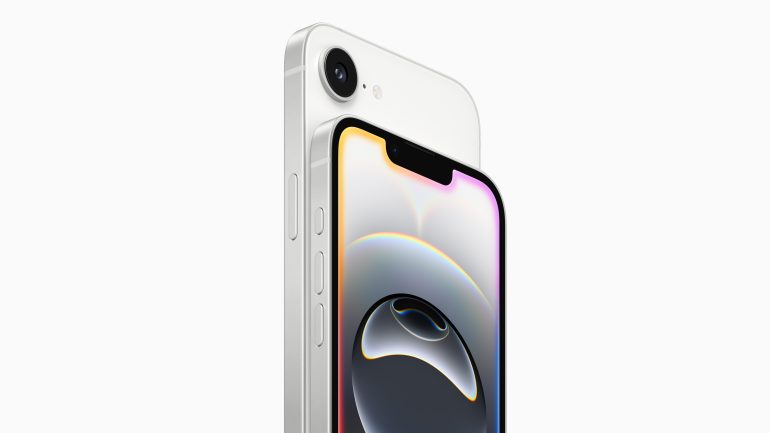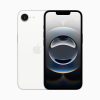Apple doesn’t do “budget.” Instead, it does accessible. The iPhone SE was its gateway drug, a way to lure users into the ecosystem with a familiar design at a lower price. But the iPhone 16e? It’s something else entirely. It’s not an SE, but it’s not quite an iPhone 16 either. It exists in a liminal space — one where Apple is trying to redefine what an entry-level iPhone should be. The result is a phone that is capable, but one that also highlights Apple’s growing identity crisis.
The ghost of iPhones past
If you’ve used an iPhone before, the 16e will feel instantly familiar. But when you place it next to an iPhone 16 Pro, something strange happens: it looks smaller. Even though the 16e has a 6.1-inch display and the 16 Pro has a 6.3-inch screen, the thicker bezels and notch make it seem more compact. Yes, you read that right, the notch is back. While the rest of the iPhone 16 lineup has moved on to the Dynamic Island, the 16e stubbornly clings to 2021’s design language. Weirdly, this wasn’t what bothered me most. Sure, the Dynamic Island is genuinely useful, but its absence isn’t a deal-breaker.
What did drive me slightly mad was the 60Hz display. After you’ve lived with 120Hz ProMotion, going back feels like watching a flipbook animation. Everything judders just enough to trigger that “something’s not right” feeling in your brain. Even worse was losing the Always On Display — I didn’t realise how often I glance at my phone for quick info until I had to keep waking this thing up.
But the truly baffling choice? No MagSafe. I personally don’t use many MagSafe accessories anymore (after losing my MagSafe wallet twice in Dubai, I’ve learned my lesson), but removing what has become a core iPhone feature feels like buying a car that’s missing its infotainment system. It’s 2025, Apple — what gives?
The battery that could
If there’s one unqualified win for the 16e, it’s battery life. This thing refuses to die. The endurance reminds me of the legendary iPhone 13 Pro days when Apple briefly solved the battery anxiety problem. You can go through a full day without ever feeling the need to reach for a charger.
One camera to rule them… somewhat?
Apple’s computational photography continues to impress, even when working with less hardware. The 16e’s single camera system shouldn’t be this good, but it is.
In good light, the iPhone 16e performs admirably compared to the standard iPhone 16 models. Portrait mode on the 16e handles edge detection surprisingly well, though it occasionally struggles with complex patterns.
Where limitations become obvious is in challenging lighting situations. The lack of an ultra-wide lens also means you’ll miss out on those expansive shots that have become a smartphone photography staple.
The 16e excels at balanced exposures in daylight photography, producing images with excellent dynamic range and natural color reproduction. However, it struggles with night photography, producing noisier images and requiring longer exposure times than its siblings.
Video quality remains typically iPhone-solid, though without the cinematic modes and ProRes options of pricier models.





The AI elephant in the room
Apple has promised that the 16e can handle Apple Intelligence, but the reality in March 2025 is decidedly mixed. After WWDC 2024’s impressive demos and months of marketing showing off a Siri that actually understands context, what we have is… well, incremental at best.
While I appreciate Apple’s approach of wanting to partner with various AI models rather than locking into a single solution, the practical implementation lags behind what Samsung is already offering across its lineup. The mid-range Galaxy A56 has more useful AI features today than this iPhone does — a sentence that would have been unthinkable a few years ago.
The awkward middle child
So who exactly is the iPhone 16e for? That’s the problem — Apple doesn’t seem entirely sure.
For teenagers getting their first iPhone or parents who just want a reliable device with a decent camera, it makes some sense. But the compromises would be easier to swallow if the price were a bit lower. When the Samsung Galaxy A56 offers comparable performance (to a degree), better AI integration, and six years of software updates at a more competitive price point, Apple’s value proposition gets murky.
The strange thing is, Apple never used to be this confused about product positioning. The company that once prided itself on a small, focused lineup now seems to be throwing spaghetti at the wall to see what sticks.
Not quite what we hoped it would be
The iPhone 16e isn’t bad — it’s just caught in a strange middle ground. It has the core iPhone experience, a genuinely good camera considering its limitations, and phenomenal battery life. In day-to-day use, the 16e feels like a throwback to the iPhone XR rather than an evolution of the SE and iOS remains more polished than Android, even as that gap continues to narrow.
But it’s missing features that now define the iPhone experience for many users: the fluid 120Hz display, MagSafe compatibility, and a fully realised version of Apple Intelligence.
In South Africa, where premium devices carry an even steeper premium, these compromises feel particularly acute. The iPhone 16e is still worth buying, but only for very specific people — those who absolutely must have an iPhone but don’t care about the bells and whistles of higher-end models.
Using the 16e shows just how much the iPhone has been refined over the years. The core experience remains solid, but the difference between this and the rest of the iPhone 16 models highlights Apple’s increasingly segmented approach to its product line.
The unusual culmination of hardware and software decisions, as well as the “e” moniker, suggest that Apple sees the 16e as something distinct — perhaps a bridge between product lines rather than a continuation of one.
However the Cupertino giant views the handset, it’s worth buying, but only for a select audience.



